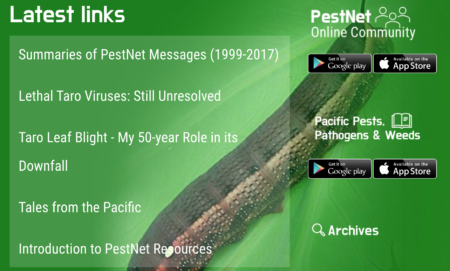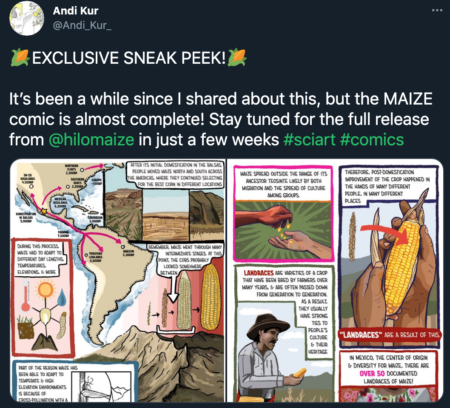- Unlocking big data doubled the accuracy in predicting the grain yield in hybrid wheat. Breeding programmes and genebanks need to pool their data. That’s kind of what the Plant Treaty’s GLIS is for, isn’t it?
- Resequencing of 672 Native Rice Accessions to Explore Genetic Diversity and Trait Associations in Vietnam. Another example of the above: an indica sub-population in Vietnam is pretty unique and seemingly untapped in breeding.
- Quantifying apple diversity: A phenomic characterization of Canada’s Apple Biodiversity Collection. And another: 20,000 apples phenotyped to within an inch of their lives to show, among many other things, that new varieties have been getting lower in phenolics.
- Towards a Joint International Database: Alignment of SSR Marker Data for European Collections of Cherry Germplasm. I swear I didn’t plan this…
- Morphological and eco-geographic diversity analysis of maize germplasm in the high altitude Andes region of Ecuador. Loja province is a bit of a maize diversity hotspot, and you don’t need big data to prove it.
- The transition to agricultural cultivation of neo-crops may fail to account for wild genetic diversity patterns: insights from the Cape Floristic Region. Taking a new species into cultivation can lead to a genetic bottleneck, and you don’t need big data to prove it.
- Fish domestication in aquaculture: 10 unanswered questions. Same as above for fish, but oddly genetic diversity doesn’t feature among the questions. Maybe the answer would have been too obvious?
- Transition From Wild to Domesticated Pearl Millet (Pennisetum glaucum) Revealed in Ceramic Temper at Three Middle Holocene Sites in Northern Mali. How wild pearl millet was taken into cultivation can be followed in time because bits of the plants were added to clay to prevent the pots cracking during firing in ancient times. The opposite of big data, but still pretty cool.
- Africa’s evolving vegetable seed sector: status, policy options and lessons from Asia. Seed companies in Africa need capacity, policies, extension, and marketing. And data, I would add.
- Are the modern-bred rice and wheat cultivars in India inefficient in zinc and iron sequestration? Eat more vegetables? Don’t need data to figure that out.
- A history of Australian pasture genetic resource collections. 85,000 accessions qualifies as pretty big. Not sure about the data though.
Brainfood: Food systems & biodiversity, Tree diversity, Cereal micronutrients, African crops in America, Coffee vulnerability, Coffee fungus, Wildrice, Wild coriander, Wild apple genebank, Laperrine’s olive, Maize landraces, Goat domestication, Honey bee cryo
- Biodiversity Towards Sustainable Food Systems: Four Arguments. For the record: food/nutrition security, climate change resilience, sustainable diets, resilience to zoonoses. I would have added something about culture.
- Biodiversity–productivity relationships are key to nature-based climate solutions. Greenhouse gas mitigation helps tree diversity helps productivity helps greenhouse gas mitigation.
- Genetic determinants of micronutrient traits in graminaceous crops to combat hidden hunger. Big crops can help little crops.
- Contributions of African Crops to American Culture and Beyond: The Slave Trade and Other Journeys of Resilient Peoples and Crops. Decolonizing American agriculture.
- Vulnerability of coffee (Coffea spp.) genetic resources in the United States. Americans have a cunning plan for an African crop.
- Historical genomics reveals the evolutionary mechanisms behind multiple outbreaks of the host-specific coffee wilt pathogen Fusarium xylarioides. Coffee Wilt Disease fungus got a boost from banana Panama Disease fungus. Got a plan for this?
- Improved Remote Sensing Methods to Detect Northern Wild Rice (Zizania palustris L.). They’re this close to putting in place an early warning system. Coffee next? But what about those micronutrients, eh?
- Wild coriander: an untapped genetic resource for future coriander breeding. Not only untapped, its very existence was in doubt. Detect this from space, Colin!
- Advanced genebank management of genetic resources of European wild apple, Malus sylvestris, using genome-wide SNP array data. The Dutch field collection can be managed as a single unit. Kind of a relief, probably. Coffee next?
- Contrasting Genetic Footprints among Saharan Olive Populations: Potential Causes and Conservation Implications. Looks like the wild Saharan olive cannot be managed as a single unit. Bet they can be monitored from space though.
- Growing maize landraces in industrialized countries: from the search for seeds to the emergence of new practices and values. Two contrasting approaches by farmers’ associations in France and Italy.
- Herded and hunted goat genomes from the dawn of domestication in the Zagros Mountains. Before goats were morphologically domesticated, they were managed and genetically domesticated. I wonder if coffee was the same.
- Europe’s First Gene Bank for Honey Bees. Really cold drone semen finds a home in Germany.
PestNet launches new website
PestNet is a network that helps people worldwide obtain rapid advice and information on crop protection, including the identification and management of plant pests. It started in 1999. Anyone with an interest in plant protection is welcome to join. PestNet is free and is moderated, ensuring that messages are confined to plant protection.
…
You can become a PestNet member at no cost either via the online app or the Android mobile app. Once joined you can post pest diagnostic requests, seek advice on any other plant protection matter, respond to requests from other members, and access new articles relevant to plant protection via the apps. You can access both the online version of PestNet as well as the Mobile (Android) version via the drop down menu under “Resources”.

And now it’s got a brand new website, with some really interesting additional resources. One of these is a long but fascinating read from Grahame Jackson, the driving force behind PestNet, describing his role in the fight against Taro Leaf Blight in the Pacific. If you’re interested in how crop genetic diversity can be used to combat pests and diseases, you’ll love Grahame’s story.
Maize comic in the offing
Well this looks super-cool.
Brainfood: Insurance, Maize roots, Grass strips, Banana nutrients, Fish nutrients, Wild potatoes, Apple genes, Wheat resistance, Killer tomatoes
- Biodiversity as insurance: from concept to measurement and application. It’s important to draw a distinction between the effect of biodiversity on mean and on variance of ecosystem properties.
- Reproductive resilience but not root architecture underpins yield improvement under drought in maize (Zea mays L.). Which presents an opportunity.
- Functional traits driving pollinator and predator responses to newly established grassland strips in agricultural landscapes. Biodiversity takes its time.
- Genetic diversity in fresh fruit pulp mineral profile of 100 Indian Musa accessions. Plenty of diversity, though different micronutrients are correlated, and 100 g contributes only 5-10% of daily mineral requirements.
- Declining diversity of wild-caught species puts dietary nutrient supplies at risk. Let them eat bananas. More nuance.
- A Metric for Species Representation in the US Potato Genebank. Sort of like a core collection, but across species.
- Pyramiding resistance genes and widening the genetic base of the apple (Malus × domestica Borkh.) crop. From 36 cultivars, via 110 cross combinations, to 7,876 offsprings, to 2,969 after screening, to 75 genotypes each with 2-3 of the 20 Rvi6 genes. Hard row to hoe.
- Resistance to diseases in samples of rare wheat species from the N.I. Vavilov All-Russian Institute of Plant Genetic Resources. Very hard row to hoe. Septoria nodorum blotch seems to be particularly tricky.
- Alien introgression and morpho‑agronomic characterization of diploid progenies of Solanum lycopersicoides monosomic alien addition lines (MAALs) toward pre‑breeding applications in tomato (S. lycopersicum). I particularly like the bit where it bursts through John Hurt’s chest.
